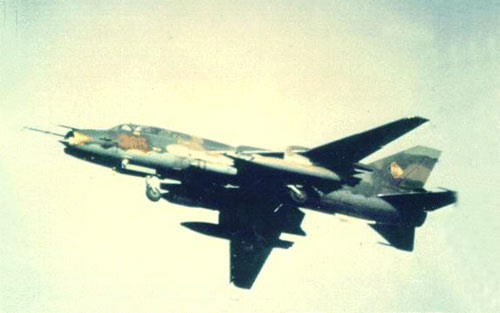Su-17 Fitter
Summary
| Category | Combat Aircraft |
| Origin country | 🇨🇳 Ex-USSR |
| Manufacturer | Sukhoi |
| First flight | 1 January 1966 |
| Year introduced | 1971 |
| Number produced | 2867 units |
| Average unit price | $6 million |
Description
The Su-17 Fitter is a Soviet-designed single-seat, twin-engine supersonic fighter-bomber. It was developed in the 1960s by the Sukhoi Design Bureau as a variable-sweep wing development of the Su-7 fighter-bomber.
The first prototype, known as the Su-7IG, flew in 1966 with fixed wings. The second prototype, designated Su-17, flew in 1967 with variable-geometry wings allowing sweep settings between 28 degrees and 62 degrees. The Su-17 entered service with the Soviet Air Force in 1971.
The Su-17 had a metal semi-monocoque fuselage and double-delta variable sweep wings. Early versions were powered by two Lyulka AL-7F1 afterburning turbojet engines, while later models had more powerful Lyulka AL-21F engines. Some export versions used other engine types like the Tumansky R-29.
The variable geometry wings gave the aircraft excellent performance across a wide speed and altitude range. Sweep angles could be adjusted manually by the pilot or automatically based on airspeed and g-forces. Later models added canard foreplanes for improved maneuverability.
The Su-17 can carry a variety of air-to-ground weapons on nine hardpoints, including rockets, bombs, missiles, and gun pods. Typical weapon loads include rockets, free-fall bombs, cluster bombs, napalm tanks, rocket pods, and air-to-surface missiles like the Kh-23 Grom and Kh-25ML. Internal armament is a single 30mm GSh-30-2 cannon with 200 rounds.
The Su-17 entered Soviet service in 1971 and was widely used in the 1970s and 1980s. It saw combat during the Yom Kippur War in 1973, Ethiopian-Somali Border War, Soviet war in Afghanistan, Iran-Iraq war, and other conflicts. More than 2800 were built.
The export version Su-20 was sold to a number of countries including Libya, Angola, Poland, Czechoslovakia, East Germany, Hungary, and others. The Su-22 variant was exported to Syria, Iraq, and other middle eastern nations.
Notable variants include the Su-17M with Lyulka AL-21F engine, the export Su-22M with revised avionics, the naval Su-17UM trainer, and the Su-17M4 with canards and single-wheel nose gear. Advanced versions remain in limited service today in some air forces.
Technical specifications
| Version: Su-17 Fitter | |
|---|---|
| Crew | 1 pilot |
| Operational range | 950 km (590 mi) |
| Maximum speed | 2140 km/h (1330 mph) |
| Wing area | 27.5 m² (296.0 sqft) |
| Wingspan | 10.0 m (32.6 ft) |
| Height | 4.5 m (14.8 ft) |
| Length | 15.3 m (50.0 ft) |
| Service ceiling | 14,500 m (47,572 ft) |
| Empty weight | 5,932 kg (13,078 lbs) |
| Max. takeoff weight | 7,890 kg (17,394 lbs) |
| Climb rate | 47.6 m/s (156.2 ft/s) |
| Powerplant | 1 × turbojet TR-3 delivering 4000 kgp, up to 4600 kgp with afterburner |
Current operating countries
| Country | Units | ||
|---|---|---|---|

|
Syria | 39 | |

|
Poland | 32 | |

|
Vietnam | 32 | |

|
Yemen | 23 | |

|
Iran | 18 | |

|
Angola | 14 | |

|
Libya | 1 | |
All operators

